Charts of the Week
Current economic trends from 8 to 12 March 2021: exports and imports of goods, manufacturing, electricity consumption, traffic of electronically tolled vehicles and other charts
The relatively favourable developments in the export part of the economy continued at the beginning of the year. Manufacturing output, which was close to pre-epidemic levels year on year at the end of 2020, rose in January. Exports of goods to EU countries, which also reached pre-crisis levels at the end of last year, have remained at a similar level since November.
Electricity consumption and freight traffic on Slovenian motorways were somewhat lower year on year at the beginning of March. The decline in the number of registered unemployed persons strengthened slightly in the middle of March, which is also related to the gradual easing of containment measures. According to data on fiscal verification of invoices, the relaxation of measures contributed to a further decline in the year-on-year fall in turnover at the end of February and the beginning of March, particularly in retail trade, but – due to the possibility of offering services to legal persons – also in food and beverage service activities.
Exports and imports of goods, January 2021
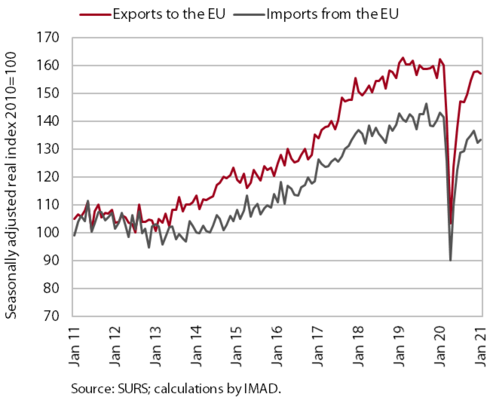
Goods trade ceased to recover in December and January. Real exports of goods to EU countries, which reached pre-crisis levels at the end of last year, have maintained a similar level since November. The standstill in the recovery of export activity was significantly influenced particularly by road vehicle exports. Exports of intermediate goods and some high-technology consumer goods increased further. Export expectations remained favourable in February and companies were more optimistic regarding future foreign demand than before the beginning of the epidemic. The recovery of imports has also stalled in recent months, which is mainly related to a fall in private consumption in Slovenia due to containment measures and less to the moderation of growth in industrial activity.
Manufacturing, January 2021
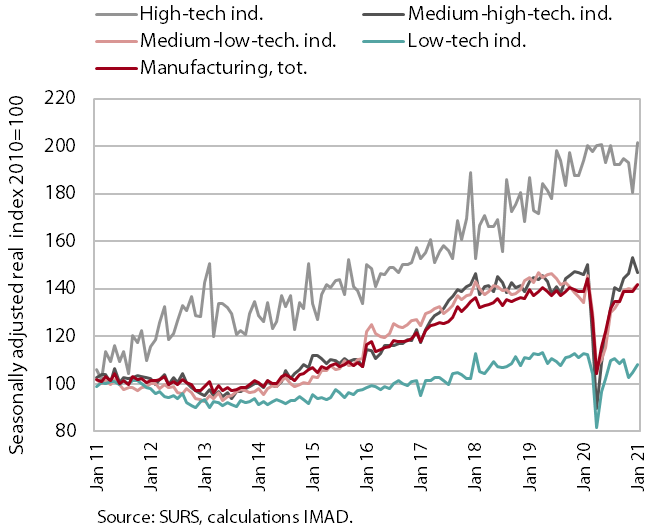
Manufacturing production again strengthened somewhat in January, after stagnation in the previous two months. Following a decline in November and December, the strongest growth was recorded in high-technology industries. Production also increased in medium-low- and low-technology industries, while in medium-high-technology industries the strengthening of production came to a halt. Despite the increase, manufacturing production was down year on year in January, particularly due to a fall in the manufacture of motor vehicles (also as a major car manufacturer halted production until the middle of the month) and the majority of low-technology industries. In high-technology industries, production was higher year on year in the manufacture of computer, electronic and optical products, while in medium-low-technology industries, only the manufacture of other non-metallic mineral products recorded more modest results than in the same period last year.
Electricity consumption, March 2021
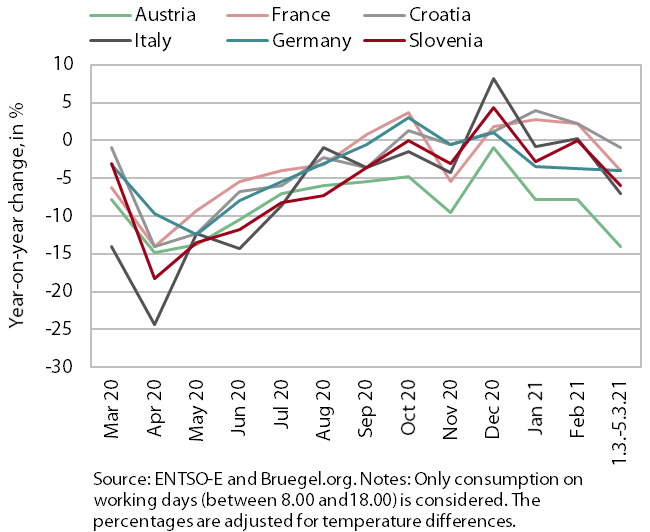
The year-on-year fall in electricity consumption deepened in the first week of March. After the relaxation of containment measures in February, when electricity consumption was mostly the same as last year, a year-on-year fall of 6% was recorded at the beginning of March. A deepening of the year-on-year decline was also recorded in the majority of Slovenia’s main trading partners. In Austria, the year-on-year decline was almost the same as at the beginning of the first wave of the epidemic (14%). In Croatia, France and Italy, where in previous weeks consumption had mostly been the same or higher than last year, electricity consumption was 1%, 4% and 7% lower year on year, respectively. In Germany, the year-on-year decline remained at 4%.
Traffic of electronically tolled vehicles on Slovenian motorways, March 2021
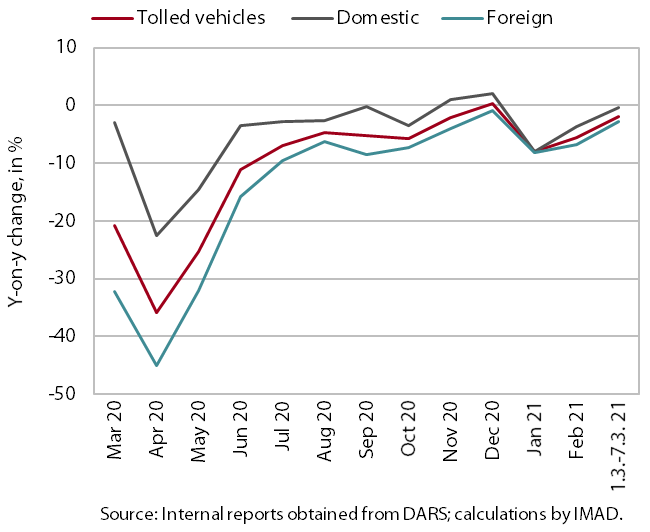
Freight traffic on Slovenian motorways in the first week of March was 2% lower year on year. Between 1 and 7 March, domestic vehicle traffic was unchanged year on year, while foreign vehicle traffic was 3% lower. Freight traffic remained very high. It was, however, also high in the comparable week of 2020, the last before the declaration of the epidemic. In the following weeks, the year-on-year comparison will show strong growth due to the low-base effect (lower traffic due to the epidemic).
Registered unemployment, March 2021
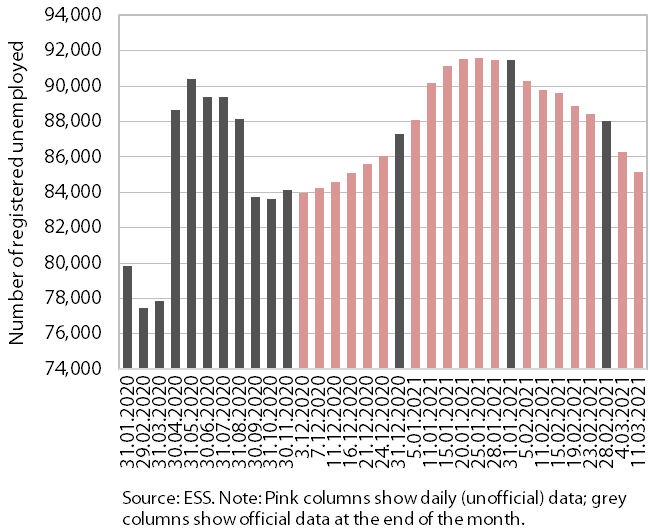
The decline in the number of registered unemployed persons strengthened somewhat further in March. The adoption of intervention measures to preserve jobs during the first wave of the epidemic and the subsequent easing of restrictions on businesses stemmed the high growth of unemployment in May last year. The number of unemployed persons thus decreased gradually from July to September and remained at a similar level until the end of November. With intervention measures still in place, the increases in December and January did not deviate significantly from seasonal increases in the same period of previous years. The seasonal decline in the number of unemployed, which started at the end of January, continued in February. A fall was also observed at the beginning of March. This is related to seasonal factors, but also to the gradual relaxation of restrictions. Overall, 85,159 persons were unemployed on 11 March according to ESS unofficial (daily) data, which is 3.3% less than at the end of February and around 9% more than in the same period last year.
Fiscal verification of invoices, February–March 2021
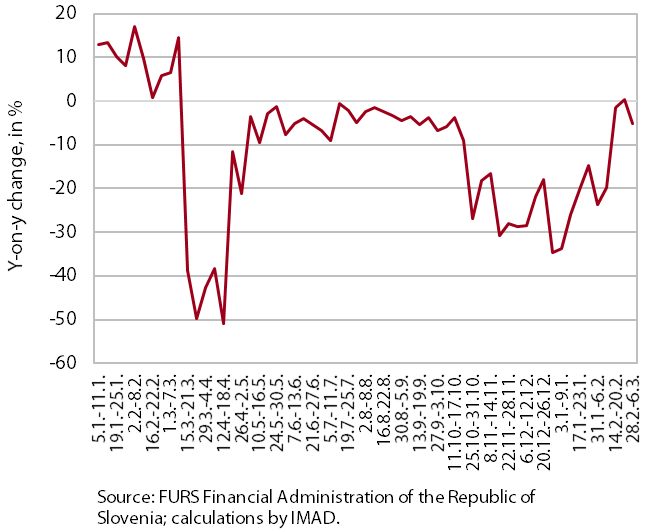
According to data on fiscal verification of invoices, the year-on-year fall in turnover decreased further at the end of February and the beginning of March. The lifting of restrictions on shops and movement between municipalities was reflected particularly in improved turnover in retail trade, which, amid the compensation of foregone household purchases, was up year on year in the last three weeks analysed. In this period, a smaller decline was also recorded in the majority of reopened sports and personal care facilities, as well as in food and beverage service activities, given the additional explanations regarding the possibility of offering services to legal persons. After year-on-year growth in the second half of February, in the first week of March turnover was again down year on year in the sale of motor vehicles and wholesale trade. The year-on-year decline remains largest in tourism-related activities (gambling and betting, travel agencies, accommodation), which mostly remain closed.
